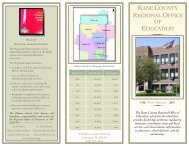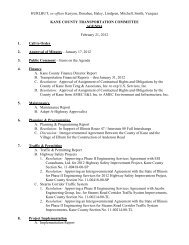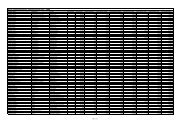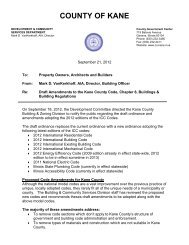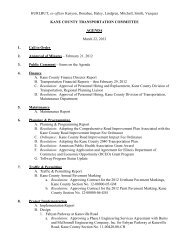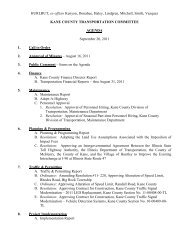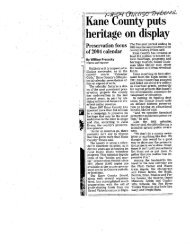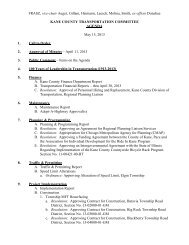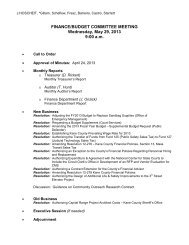kane county stormwater technical guidance manual - Kane County, IL
kane county stormwater technical guidance manual - Kane County, IL
kane county stormwater technical guidance manual - Kane County, IL
You also want an ePaper? Increase the reach of your titles
YUMPU automatically turns print PDFs into web optimized ePapers that Google loves.
§ T300(g) Limitation on Site Disturbance<br />
The limitation on site disturbance is in recognition of the need to prevent<br />
erosion in preference to controlling sediment. Site disturbances shall not<br />
exceed 20 acres at any one time unless it is to balance cut and fill, for which a<br />
maximum of 40 acres may be disturbed at any one time. The Administrator<br />
has considerable flexibility to vary the maximum area of disturbance based on<br />
site or project specific conditions, or in recognition of a particularly effective<br />
plan with aggressive and effective implementation. The amount of area open<br />
to erosion at any one time poses a risk for delivery of sediment downstream<br />
and the risk needs to be minimized consistent with the requirements of getting<br />
the project constructed.<br />
The plan for limiting disturbance should be fully developed with both the<br />
applicant and the contractor and may not be finalized until a permit is issued<br />
but before construction. It should also be flexible to meet the challenges of<br />
<strong>Kane</strong> <strong>County</strong> weather patterns in the prime construction season.<br />
Certain areas will be disturbed repeatedly, such as utility corridors and haul<br />
roads. These areas are not exempt from sediment and erosion control, but<br />
when defined on a plan or in the field, do not become subject to the limitation<br />
on disturbed area.<br />
Areas such as sedimentation basins and detention/retention facilities are also<br />
exempt from the area limitations.<br />
Outside the normal spring and fall planting seasons, temporary stabilization<br />
may be accomplished by hydroseeding with heavy mulch. Multiple<br />
treatments may be necessary to adequately stabilize the site. The use of<br />
erosion control blankets with or without seed also meet the requirements.<br />
Permanent stabilization requires the placement of seed or sod. In the case of<br />
dormant season seeding the use of erosion control blankets or heavy<br />
mulching with permanent seeding satisfies the requirement. The use of<br />
heavy mulch may require multiple treatments depending on weather<br />
conditions and dislodgment protection.<br />
§ T300(h) Erosion and Sediment Control Plan Requirements<br />
Figure 16 illustrates the minimum components necessary for an erosion and<br />
sediment control plan sheet. The plan should clearly detail all phases of site<br />
construction and the erosion and sediment control practices to be installed.<br />
All permanent stabilization is to be shown on a separate plan sheet using<br />
practices shown in Table 8.<br />
<strong>Kane</strong> <strong>County</strong> Technical Guidance Manual 54



